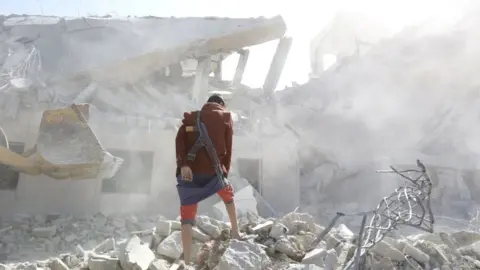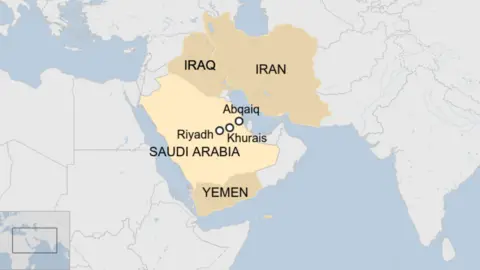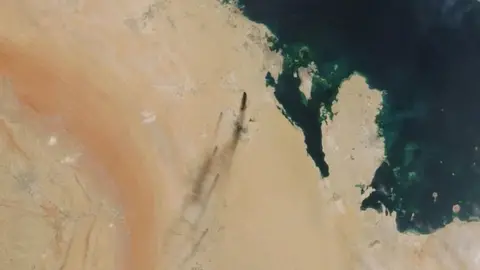'Drone' attack on Saudis destabilises an already volatile region

 EPA
EPAThe Houthis say they did it; the United States insists that it was Iran; the Iranians deny any involvement.
A predictable war of words has followed the dramatic attack on Saudi Arabia's most important oil installations. The strikes have shown the remarkable vulnerability of oil facilities of central importance to the global economy.
The Saudis - whose air campaign in Yemen is backed by the Americans and whose warplanes are only kept in the sky by a variety of western contractors - have been conducting a long-running air campaign against the Houthi rebels. But their opponents have now demonstrated the ability to deliver a strategic riposte of their own.
The whole episode has inevitably revived the debate about the extent to which Iran is providing technology and assistance to the Houthis. Given the already highly charged atmosphere in the Gulf, it has served to ratchet up regional tensions.
But equally it has also revealed some of the failings in the Trump administration's declared policy of exerting "maximum pressure" against Tehran.
Amidst the claims and counter-claims, there is still a good deal that we do not know. The Houthis have used both drones and missiles to hit Saudi targets before.
But the drone attacks have generally had only limited success. Both the range over which this most recent operation was conducted and the accuracy and scale of the strikes make this a different order of magnitude altogether.
So was it really armed drones (UAVs) that conducted these attacks, or was it some kind of missile strike? And if the latter, why were Saudi air defences not alerted? Were the attacks launched from Houthi-controlled territory or from somewhere else? Might pro-Iranian groups in Iraq have been involved or maybe the Iranians themselves?
The US Secretary of State Mike Pompeo was quick to point the finger of blame at Tehran, but he did so seemingly before any clear intelligence was available; certainly he did not offer any of it up for immediate public scrutiny.
 Getty Images
Getty ImagesSeveral hours later, US sources indicate that there were some 17 points of impact from the attack, all suggesting that they came from the north or north-west - that is to say, more likely from Iran or Iraq, rather than from Yemen to the south.
The US is promising more details in due course and some of the drones or missiles that failed to reach their targets are now being analysed.
Iran has well-developed ties with the Houthis and there is little doubt it has been the key player in enabling them to develop their long-range strike capability, whether through armed UAVs or missiles.
In 2018, a report from a UN expert panel pointed to the remarkable similarity between the Houthi Qasef-1 UAV and the Iranian Ababil-T. In a wide-ranging study, it asserted that Iran had broken the arms embargo against Yemen and supplied the Houthis with a variety of weapons systems.
Much the same conclusion was reached by a March 2017 study from the independent Conflict Armament Research organisation, which focused on Iranian UAV assistance.

However, the Qasef-1/Ababil-T only has a range of about 100-150km. The distance from the Yemeni border to the closest target - the Khurais oil field - is about 770km. So if these recent attacks were carried out by a UAV it would have to have been of an altogether different design, with hugely increased range and a significantly greater level of reliability.
Iran and thus possibly the Houthis do indeed have longer-range systems, but so far there has been little evidence of their deployment in the Yemen conflict. Some kind of cruise missile might also be a possibility, perhaps fired from either Iraq or Iran, but clarity on these questions will require access to reliable intelligence information.
In some ways, though, the precise details don't matter. The diplomatic damage has already been done. The US and the Saudis are implacable enemies of Iran. The Trump administration has already made its mind up, blaming Tehran for the mining of ships in the Gulf. Iran has openly seized a British-flagged tanker, albeit after the arrest of a ship carrying Iranian oil off Gibraltar.
So as far as team Trump is concerned, the Iranians' fingerprints are all over the Houthis' escalating strategic campaign against Saudi Arabia's oil infrastructure.
 Getty Images
Getty ImagesThe question now is what are they going to do about it, or perhaps what can they do about it? And the answer may be: not very much. The US is already firmly in the Saudi corner, despite the growing unpopularity of the Yemen war on Capitol Hill, where there is a growing sense that the Saudi air campaign is pointless, serving only to turn an already impoverished country into a humanitarian disaster zone.
But there is a curious aspect revealed by these infrastructure attacks. For all the Trump administration's support for the Saudis and for all its stress on "maximum pressure", in reality, Washington is sending very mixed signals to Tehran.
 NASA
NASAMr Trump, after all seems, willing to countenance a face-to-face meeting with the Iranians on the margins of the upcoming UN General Assembly and he has just fired his National Security Adviser, John Bolton, the man most associated with the idea of regime change in Tehran.
Iran, along with its Houthi allies, is conducting a classic war of the weak against the strong; a "hybrid conflict" as it is known in the strategic textbooks. It is borrowing many of the tactics from the Russian play-book - the use of deniability; proxies; cyber-operations and information warfare.
Tehran knows that Mr Trump, for all his bluster and unpredictability, wants to get the US out of military entanglements and not into new ones. That gives the Iranians the ability to apply some "maximum pressure" of their own.
The danger remains that miscalculation could lead to an all-out conflict, which nobody really wants.
